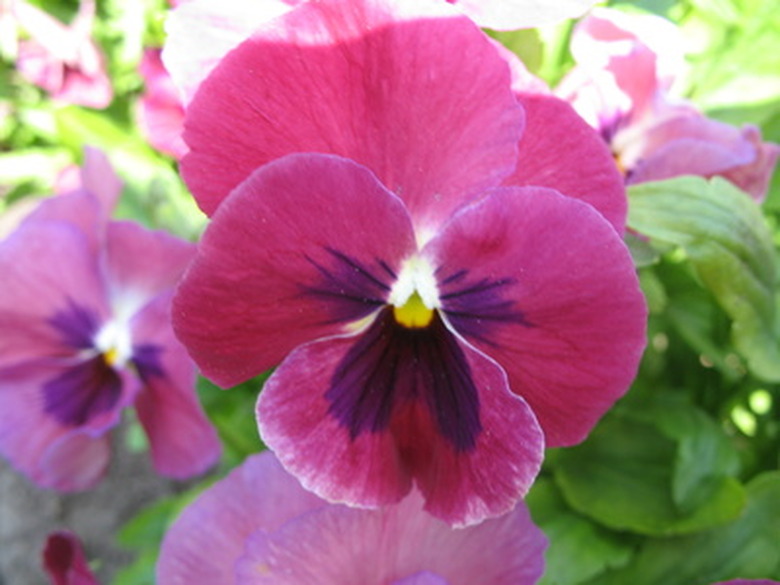Flower Names That Begin With P
Gardeners often plant flowers to add vibrant color, ornamental interest and ground covers to their landscapes. If you would like to plant flowers, select varieties according to your United States Department of Agriculture (USDA) Hardiness Zone, bloom time, flower color, potential problems and intended use. Many flower varieties begin with the letter "P."
Pansy
Pansies (Viola x wittrockiana), bloom from April through June, featuring blossoms with blue, red, purple, yellow, pink or bicolored petals. This violet family member (Violaceae) generally performs well in USDA Zones 6 to 10. These herbaceous perennials range from six to nine inches in height with slightly larger spreads. Pansies like moist, humusy soils in partly to fully sunny locations. Fungal diseases and snails sometimes affect the foliage. Gardeners primarily use pansies in flowerbeds, containers and window boxes.
- Gardeners often plant flowers to add vibrant color, ornamental interest and ground covers to their landscapes.
- Gardeners primarily use pansies in flowerbeds, containers and window boxes.
Pitcher Plant
Pitcher plants (Sarracenia oreophila), also known as the mountain trumpet plant, naturally occur in Georgia and Alabama. Winter hardy in in USDA Zones 6 to 8, this herbaceous perennial likes wet, acidic soils that receive plenty of sunlight. This Sarraceniaceae plant family member ranges from 12 to 24 inches in height with similar spreads. These carnivorous plants trap insects by luring them into their modified, pitcher-like leaves. The yellow flowers and leaves generally die back by the middle of summer, giving way to iris-like, green leaves that remain throughout the winter. Mealybugs, root rot and leaf spot occasionally occur. Gardeners typically plant pitcher plants in bog gardens.
- Pitcher plants (Sarracenia oreophila), also known as the mountain trumpet plant, naturally occur in Georgia and Alabama.
Prairie Phlox
Prairie phlox (Phlox pilosa), sometimes called downy phlox, naturally grows in the south-central United States and generally thrives in USDA Zones 4 to 9. This Polemoniaceae plant family member ranges from one to two feet in height with similar spreads. Prairie phlox features hairy stems, green leaves and fragrant clusters of rose-colored flowers that appear from May through July. This herbaceous perennial likes moist, clay or sandy soils that receive plenty of sun. The prairie phlox handles dry soils better than other phlox species. Spider mites sometimes infest plants growing in hot, arid climates. Gardeners often use the prairie phlox as ground covers in meadows, rock gardens, prairies and open woodlands.
- Prairie phlox (Phlox pilosa), sometimes called downy phlox, naturally grows in the south-central United States and generally thrives in USDA Zones 4 to 9.
- The prairie phlox handles dry soils better than other phlox species.
Peony
Peonies (Paeonia obovata), herbaceous perennials in the Paeoniaceae family, naturally occur in Japan and China. Hardy in USDA Zones 5 to 8, mature plants range from 12 to 24 inches in both height and spread. Slightly fragrant blossoms appear in May, featuring cup-like, white, purple, rose or red flowers. The peony likes rich, moist soils in partly shady positions. Phytopthora blight and Botyrtis blight occasionally affect this plant. Gardeners often use peonies in shade gardens, shady borders and open woodland gardens.
Purple Rocket
Purple rockets (Iodanthus pinnatifidus) belong to the mustard plant family (Brassicaceae) and perform well in USDA Zones 4 to 8. Flower clusters appear in May and June, featuring fragrant, pale purple blossoms that fade to white. This perennial prefers rich, moist to wet soils in partial to full shade positions. Mature plants range from 12 to 36 inches in height and 12 to 24 inches in width. Purple rockets grow well in moist woodlands, moist meadows and along stream flood plains.
- Peonies (Paeonia obovata), herbaceous perennials in the Paeoniaceae family, naturally occur in Japan and China.
- Hardy in USDA Zones 5 to 8, mature plants range from 12 to 24 inches in both height and spread.
